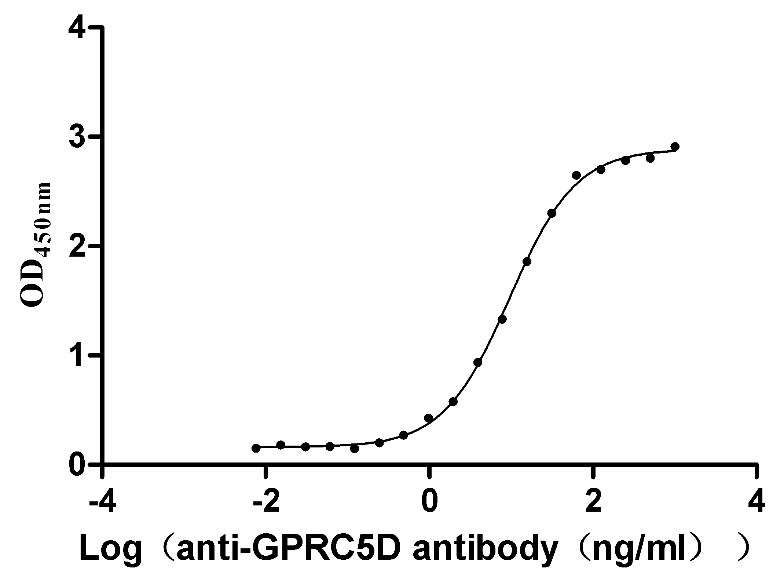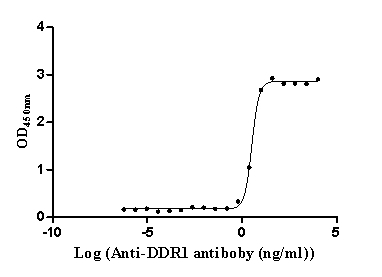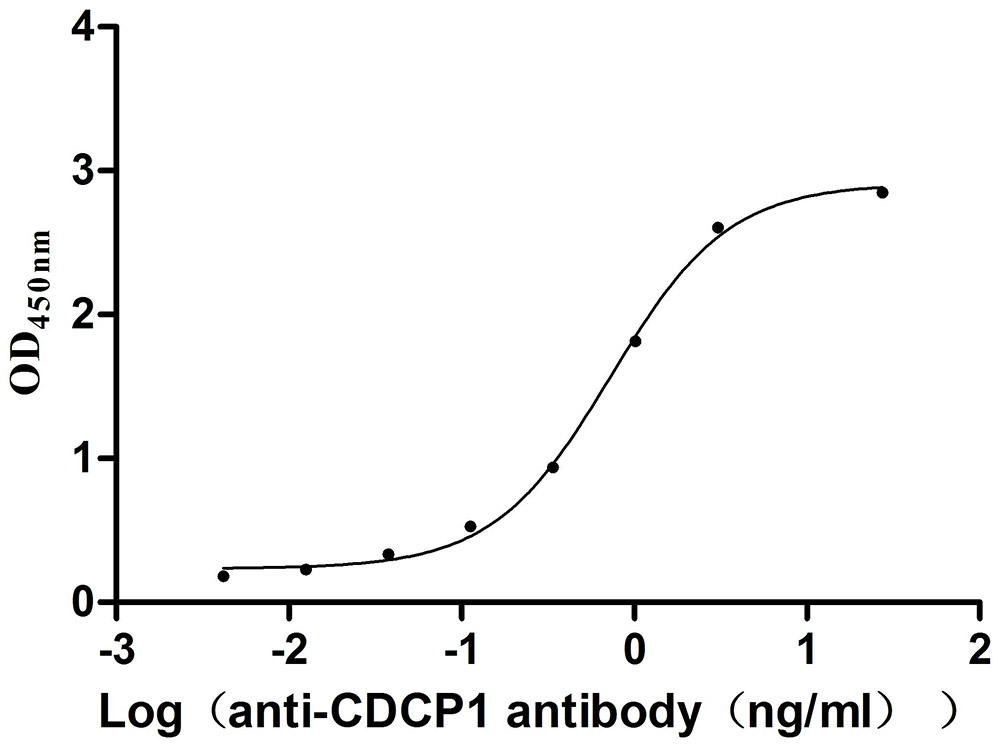Recombinant Human Inward rectifier potassium channel 13 (KCNJ13), partial
-
货号:CSB-YP012051HU1
-
规格:
-
来源:Yeast
-
其他:
-
货号:CSB-EP012051HU1
-
规格:
-
来源:E.coli
-
其他:
-
货号:CSB-EP012051HU1-B
-
规格:
-
来源:E.coli
-
共轭:Avi-tag Biotinylated
E. coli biotin ligase (BirA) is highly specific in covalently attaching biotin to the 15 amino acid AviTag peptide. This recombinant protein was biotinylated in vivo by AviTag-BirA technology, which method is BriA catalyzes amide linkage between the biotin and the specific lysine of the AviTag.
-
其他:
-
货号:CSB-BP012051HU1
-
规格:
-
来源:Baculovirus
-
其他:
-
货号:CSB-MP012051HU1
-
规格:
-
来源:Mammalian cell
-
其他:
产品详情
-
纯度:>85% (SDS-PAGE)
-
基因名:KCNJ13
-
Uniprot No.:
-
别名:KCNJ13; Inward rectifier potassium channel 13; Inward rectifier K(+ channel Kir7.1; Potassium channel, inwardly rectifying subfamily J member 13
-
种属:Homo sapiens (Human)
-
蛋白长度:Partial
-
蛋白标签:Tag type will be determined during the manufacturing process.
The tag type will be determined during production process. If you have specified tag type, please tell us and we will develop the specified tag preferentially. -
产品提供形式:Lyophilized powder
Note: We will preferentially ship the format that we have in stock, however, if you have any special requirement for the format, please remark your requirement when placing the order, we will prepare according to your demand. -
复溶:We recommend that this vial be briefly centrifuged prior to opening to bring the contents to the bottom. Please reconstitute protein in deionized sterile water to a concentration of 0.1-1.0 mg/mL.We recommend to add 5-50% of glycerol (final concentration) and aliquot for long-term storage at -20℃/-80℃. Our default final concentration of glycerol is 50%. Customers could use it as reference.
-
储存条件:Store at -20°C/-80°C upon receipt, aliquoting is necessary for mutiple use. Avoid repeated freeze-thaw cycles.
-
保质期:The shelf life is related to many factors, storage state, buffer ingredients, storage temperature and the stability of the protein itself.
Generally, the shelf life of liquid form is 6 months at -20°C/-80°C. The shelf life of lyophilized form is 12 months at -20°C/-80°C. -
货期:Delivery time may differ from different purchasing way or location, please kindly consult your local distributors for specific delivery time.Note: All of our proteins are default shipped with normal blue ice packs, if you request to ship with dry ice, please communicate with us in advance and extra fees will be charged.
-
注意事项:Repeated freezing and thawing is not recommended. Store working aliquots at 4°C for up to one week.
-
Datasheet :Please contact us to get it.
相关产品
靶点详情
-
功能:Inward rectifier potassium channels are characterized by a greater tendency to allow potassium to flow into the cell rather than out of it. Their voltage dependence is regulated by the concentration of extracellular potassium; as external potassium is raised, the voltage range of the channel opening shifts to more positive voltages. The inward rectification is mainly due to the blockage of outward current by internal magnesium. KCNJ13 has a very low single channel conductance, low sensitivity to block by external barium and cesium, and no dependence of its inward rectification properties on the internal blocking particle magnesium.
-
基因功能参考文献:
- Results confirm earlier findings that the MC4R-Kir7.1 signaling is independent of Gs-AC-cAMP signaling pathway. Furthermore, these data suggest that a noncanonical GPCR signaling pathway may be essential for this interaction. PMID: 29058194
- The activated oxytocin receptor was able to inhibit the Kir7.1 channel, an important mediator of sub retinal waste transport and K(+) homeostasis. PMID: 28603013
- KCNJ13 mutations are responsible for early-onset retinal dystrophy, featuring remarkable clumpy pigment deposits at the level of the retinal pigment epithelium, suggesting dysfunction and disorganization of this tissue. PMID: 27203561
- Kir7.1 mutations are associated with vision disorders to include novel insights into the molecular mechanism of disease pathobiology in Leber Congenital Amaurosis. PMID: 25921210
- Juvenile or early-adult-onset cataract in the setting of a congenital vitreo-retinal dystrophy notable for fibrosis over the disc and clumped pigmentation in the posterior pole is a unique phenotype that suggests recessive KCNJ13 mutations. PMID: 25475713
- Kir7.1 regulates the transition from quiescence to contractions in the pregnant uterus. PMID: 25056913
- Kir7.1, R162W mutant showed a reduction of IKir7.1 and positive shift in '0' current potential. PMID: 23977131
- Kir7.1 expression was found in 100% of choroid plexus tumors and was absent in endolymphatic sac tumors. PMID: 22706862
- A homozygous nonsense mutation was found in the potassium channel subunit gene KCNJ13 that caused leber congenital amaurosis. PMID: 21763485
- This study confirms the expression of Kir7.1 in human RPE, identifies a Kir7.1 splice variant resulting in predicted changes in protein sequence, and indicates that there is no functional interaction between this splice variant and full-length Kir7.1. PMID: 18035352
- Kir7.1 channels are modulated by intracellular protons by diverse mechanisms; H26 is important for channel activation at physiological pH(i) and it influences an unidentified proton-induced inhibitory mechanism. PMID: 18094146
- These results indicate that the KCNJ13 R162W mutation can cause Snowflake vitreoretinal degeneration and further show that vitreoretinal degeneration can arise through mutations in genes whose products are not structural components of the vitreous. PMID: 18179896
- This study demonstrates the dual regulation of Kir7.1 channel function by PKA and PKC. PMID: 18976636
显示更多
收起更多
-
相关疾病:Snowflake vitreoretinal degeneration (SVD); Leber congenital amaurosis 16 (LCA16)
-
亚细胞定位:Membrane; Multi-pass membrane protein.
-
蛋白家族:Inward rectifier-type potassium channel (TC 1.A.2.1) family, KCNJ13 subfamily
-
组织特异性:Predominantly expressed in small intestine. Expression is also detected in stomach, kidney, and all central nervous system regions tested with the exception of spinal cord.
-
数据库链接:
HGNC: 6259
OMIM: 193230
KEGG: hsa:3769
STRING: 9606.ENSP00000233826
UniGene: Hs.467338
Most popular with customers
-
Recombinant Human G-protein coupled receptor family C group 5 member D (GPRC5D)-VLPs (Active)
Express system: Mammalian cell
Species: Homo sapiens (Human)
-
Recombinant Human Epithelial discoidin domain-containing receptor 1 (DDR1), partial (Active)
Express system: Mammalian cell
Species: Homo sapiens (Human)
-
Recombinant Human Dickkopf-related protein 1 (DKK1) (Active)
Express system: Mammalian cell
Species: Homo sapiens (Human)
-
Recombinant Human Desmoglein-2 (DSG2), partial (Active)
Express system: Mammalian cell
Species: Homo sapiens (Human)
-
Recombinant Mouse CUB domain-containing protein 1 (Cdcp1), partial (Active)
Express system: Mammalian cell
Species: Mus musculus (Mouse)
-
Recombinant Rat Gastric inhibitory polypeptide receptor (Gipr), partial (Active)
Express system: Mammalian cell
Species: Rattus norvegicus (Rat)
-
Recombinant Human Serine/threonine-protein kinase receptor R3 (ACVRL1), partial (Active)
Express system: Baculovirus
Species: Homo sapiens (Human)
-
Recombinant Human Myosin regulatory light chain 12A (MYL12A) (Active)
Express system: E.coli
Species: Homo sapiens (Human)




-AC1.jpg)















